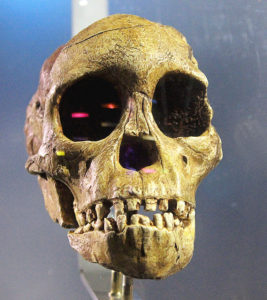By STEVEN LANG
Maropeng boasts one of the most spectacular exhibitions of human ancestors in the world. The recently discovered Homo naledi fossils are undoubtedly the showpieces of this extraordinary museum, but there is plenty more for science tourists to see.
President Thabo Mbeki officially opened Maropeng as the official Visitors’ Centre of the Cradle of Mankind World Heritage Site, in December 2005. In May this year, the Homo naledi exhibition with the original bones of two almost complete skeletons opened to the public.
Two amateur cave explorers, Rick Hunter and Steven Tucker, made the original discovery in some of the almost inaccessible reaches of the Rising Star cave system in 2013.
Since then thousands of H.naledi bones have been removed from the Lesedi and Dinaledi Chambers of the system located in the heart of the Cradle of Humankind.

Professor Lee Berger of Wits University has been in charge of operations to study the latest addition to our family tree and to ensure that 3D images of the bones are made available to scientists all over the world.
When the new H. naledi exhibition was inaugurated, Berger and his colleague, Prof John Hawks launched their book entitled Almost Human – The Astonishing Tale of Homo naledi, describing how the new species was discovered and explaining its significance to the general public.
As you enter the H. naledi exhibition space there is a life-size cutaway of the all-female team that brought more than 1 500 bones out of the Dinaledi Chamber. All explorers who have been into the chamber are noticeably lithe because the access chute to the chamber narrows to less than 20 centimetres wide.

A full size, three-dimensional replica allows visitors to try pass through the tiny chute that the cave explorers have to negotiate when entering or exiting the chamber. Most visitors do not need to even try.

The exhibition includes videos, photos and a range of riveting explanations of the bones Berger’s team has found in the Rising Star cave system. However, the highlight of the exhibition are the glass-cases containing the original H. naledi skeletons that have been studied so far.
The H. naledi bones have provoked more than their share of controversy – starting with the name of the new species. Does it belong to the Homo genus at all? While some features of the new hominin appear to fit in nicely with Homo, others are closer to more primitive Australopethecines.
One of the most contentious ideas put forward by Berger when he presented H. naledi to the world was the probability of the ancient hominins burying their dead. This prospect caused much consternation among academics because until that time it was held that only humans and Neanderthals buried their dead.
Berger argued that since it was extremely improbable that the fossils would get into the Dinaledi Chamber by chance, the dead hominins must have been deliberately put there. There was no sign of predators or flood-waters bring dead H. naledi into the cave as the case has been in many other caves.

The age of the H. naledi bones is also controversial. Initially scientists thought that the bones were just over two million years old, but later, more thorough analysis indicated that the fossils are much younger – between 236 000 and
335 000 years old.
If this dating is confirmed, it is conceivable that H. naledi and our human predecessors might have shared living spaces.
Whatever your view – read the book “Almost Human” and visit the Maropeng Visitors’ Centre.
More information can be found at: http://www.maropeng.co.za or http://www.thecradleofhumankind.net/




